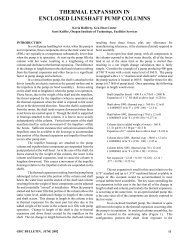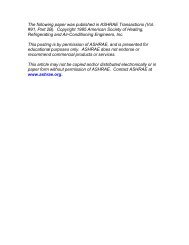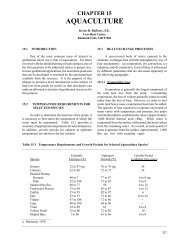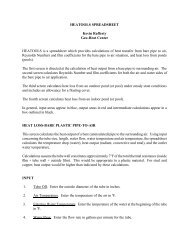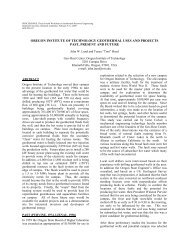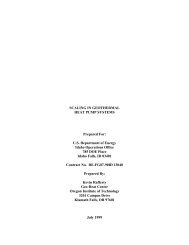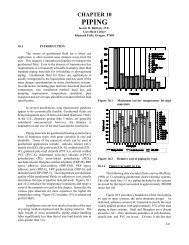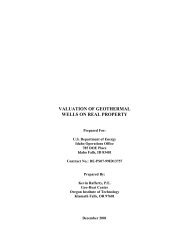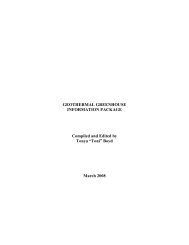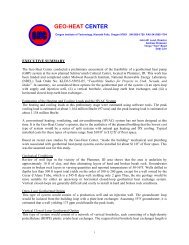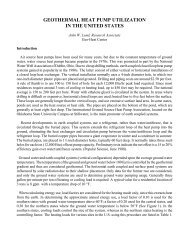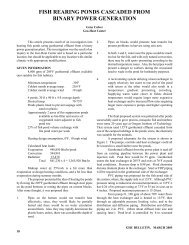"Gone Fishing" Aquaculture Project - Klamath ... - Geo-Heat Center
"Gone Fishing" Aquaculture Project - Klamath ... - Geo-Heat Center
"Gone Fishing" Aquaculture Project - Klamath ... - Geo-Heat Center
Create successful ePaper yourself
Turn your PDF publications into a flip-book with our unique Google optimized e-Paper software.
”GONE FISHING” AQUACULTURE PROJECT<br />
KLAMATH FALLS, OREGON<br />
Overview of the 72 15-ft x 100-ft fish ponds near <strong>Klamath</strong> Falls, OR.<br />
LOCATION<br />
The “<strong>Gone</strong> Fishing” aquaculture project is located<br />
about 10 miles south of <strong>Klamath</strong> Falls, Oregon, near Merrill<br />
in the Lower <strong>Klamath</strong> Valley adjacent to the <strong>Klamath</strong> Hills.<br />
The original ponds were construct in 1984 and had limited<br />
use. The present facility, operated by Ron Barnes, started in<br />
1990 using the effluent from a geothermal greenhouse<br />
operation on the Liskey Ranch on Lower <strong>Klamath</strong> Lake Road.<br />
In 1998, he purchased 80 acres of land just north of the<br />
greenhouses on the opposite side of the road. Today, the<br />
operation consists of 37 ponds located on the Liskey Ranch<br />
and 35 at the new location. The aquaculture ponds are used<br />
to raise 85 varieties of tropical fish (cichlids) that originated<br />
from Lake Malawi in East Africa’s Great Rift Valley and from<br />
Central America. He sells 250,000 of the fish (3" to 4" long)<br />
annually to tropical fish wholesalers from Portland, OR to<br />
San Francisco, CA; shipped weekly by truck to Sacramento,<br />
and then by air to the various outlets.<br />
RESOURCE<br />
The geology of the area consists of large normal fault<br />
blocks, typical of the Basin and Range province. The <strong>Klamath</strong><br />
Hills are typical of these fault blocks, allowing geothermal<br />
GHC BULLETIN, JUNE 2003<br />
waters that circulate at depth, and move to the surface in<br />
shallow aquifers. At the original location, a greenhouse<br />
complex consisting of four 6,000 square-foot buildings are<br />
heated using a peak of 400 gpm from six geothermal wells<br />
ranging in temperature from 80E to 200EF and all are around<br />
100 feet deep. The newer set of ponds are provided<br />
geothermal water from a 460-foot deep well that pumps up to<br />
300 gpm of 210EF water. The water surface in the newer well<br />
is at 120 feet and the lineshaft pump bowls are set at 190 feet.<br />
The water from the wells is alkaline with a pH of 8.8 out of<br />
the wells, but the chemical composition of the pond liners<br />
(diatomaceous earth) and soil surrounding the ponds reduce<br />
the pH to about 7.5 as the water flows through the system.<br />
The water is primarily a sodium-sulfate type of about 600 ppm<br />
that can be used directly in the ponds without harm to the fish.<br />
This is about the same chemical composition as the water of<br />
Lake Malawi.<br />
UTILIZATION<br />
At the greenhouse location, a 14,000-gallon steel<br />
railroad car tank is buried in the ground that receives water<br />
from one of the wells, and then supplies 180E to 185EF water<br />
to the greenhouses. Depending upon the outside temperature,<br />
7
the water leaves the greenhouses at 165E to 180EF; where, it<br />
is then piped to Barnes’ original ponds that are kept at nearly<br />
a constant temperature of 80EF ±3EF; even though, the fish<br />
can easily tolerate ±10EF. The wastewater from the ponds is<br />
then fed to a holding pond where it is cooled and then used for<br />
stock watering and irrigation. The water from the newer well<br />
is stored in a similar railroad car tank of 14,000 gallons and<br />
then gravity fed through a 4-inch diameter aluminum pipe<br />
adjacent to the ponds. Each pond is then supplied 197EF<br />
water through 1-inch CPVC pipe. It quickly mixes with the<br />
pond water, causing no harm to the fish, and levels out the<br />
pond water at around 80EF. The pond water is kept within<br />
3EF of the desired temperature. The wastewater, that is not<br />
lost through evaporation and leakage, is disposed of into the<br />
same stock pond. The flow to the ponds varies from 50 to 300<br />
gpm depending on the outside temperature and wind, with an<br />
annual average of about 100 gpm. A few of the ponds, which<br />
are in a more porous soil, have to be lined with black plastic<br />
to prevent severe water leakage.<br />
The temperature and flow rate into the various ponds<br />
is controlled manually by feel. Gate valves at each pond are<br />
then set to achieve the proper temperature. This “hand feel”<br />
method is felt superior to electronic control valves, as these<br />
often stick open and thus, “fry” the fish. It is felt that pond<br />
temperature is kept with ±3 o F, sufficient for optimum growth.<br />
It is estimated that the installed capacity of the newer<br />
facility, based on a peak of 300 gpm and a 10 o F-temperature<br />
drop in the water, is 1.5 million Btu/hr or 0.44 MWt. Using<br />
an annual average of 100 gpm, the total energy use is then<br />
4.38 billion Btu/yr.<br />
OPERATING COST<br />
No cost figures are available for the original ponds<br />
constructed adjacent to the greenhouses. The new ponds and<br />
well construction in 1998 were funded by two Oregon<br />
Economic Development loans for a total of $100,000. The well<br />
cost $15,000 and the excavation for the ponds cost $15,000.<br />
The remainder of the funds were used for controls, pumps,<br />
piping and storage tank. Operating cost at the original site is<br />
at a fixed rate of $350 per month, since the resource is owned<br />
by Liskey Farms, Inc. There are no pumping power costs,<br />
since the ponds are filled with wastewater from the<br />
greenhouses. At the new location, the pumping power cost<br />
varies from $280 to $400 per month with an annual average<br />
of $350 per month. The cost of electricity is 5.7 cents/kWh;<br />
thus, an average of 6,140 kW are used monthly.<br />
Approximately $500 per month is used for repairs and<br />
maintenance. Thus, the total annual operating cost is<br />
approximately $9,000. Barnes estimates that by using the<br />
geothermal heat energy, that he avoids the use of about 24<br />
million kWh in electricity annually, for a savings of<br />
$1,350,000.<br />
REGULATORY/ENVIRONMENTAL ISSUES<br />
The main concern originates from the Oregon<br />
Department of Fish and Game. They do not want any of the<br />
fish to escape into waterways in the area. As a result, a 200EF<br />
barrier is provided in the original pond area that would “cook”<br />
8<br />
any escaping fish. In the newer pond area, very little if any<br />
water overflows out of the ponds, and the little that does,<br />
mainly during the winter months, goes into a holding pond.<br />
Barnes is considering raising Tilapia and in this case, Fish<br />
and Game will require him to have a greenhouse type<br />
structure over the raising ponds and tanks to prevent any fish<br />
from escaping or being picked up and dropped by birds. The<br />
harvested fish cannot be shipped to market live, and thus must<br />
be killed and frozen on site before shipping. Also the Oregon<br />
Department of Environmental Quality would regulate the<br />
waste discharge from the Tilapia ponds; thus, a filter system<br />
would have to be installed, and a closed circuit system used.<br />
Water disposal from the tropic fish ponds is not a problem, as<br />
500 lbs of fish per pond provide little waste. Discharge from<br />
over 20,000 lbs/year would be regulated by DEQ.<br />
PROBLEMS AND SOLUTIONS<br />
Four main problems exist at the facility: 1) lack of<br />
cold water for cooling the ponds; 2) corrosion in the<br />
aluminum pipes; 3) taking of fish by birds; and 4) limited<br />
capacity of the resource. Since, this is a geothermal area, cold<br />
water is a problem for both the greenhouse and aquaculture<br />
facilities. Cold water is then provided by cooling geothermal<br />
water in holding ponds. Internal corrosion in the aluminum<br />
pipe is a problem in the new facility due to the 195EF<br />
temperature of the water. In the facility adjacent to the<br />
greenhouses, the pipes have been in for over 20 years and have<br />
experienced no corrosion, as the water temperature is only<br />
180EF. Black iron pipe placed under roads have experienced<br />
external corrosion from the soil. Birds are a problem at the<br />
older facility, since the ponds are adjacent to irrigation canals<br />
where Egrets and other birds live. This is not a major problem<br />
in the newer facility - so all that is really done at this point is<br />
to scare them away when they are working around the ponds.<br />
The maximum amount that can be pumped from the newer<br />
well is 300 gpm, and this is often reached during the winter<br />
months, especially when there is wind. This would then<br />
limited the size of the proposed Tilapia facility. Based on<br />
consultations with engineers at the <strong>Geo</strong>-<strong>Heat</strong> <strong>Center</strong>, they will<br />
experiment with two methods to reduce the evaporation.<br />
Since evaporation from the ponds can contribution to as much<br />
as 50 to 60% of the total heat loss, a wind barrier, and bubble<br />
mat pond cover are being considered. The bubble mat, similar<br />
to ones used for swimming pools and hot tubs, would cover a<br />
portion of the pond, since some of the pond area must be<br />
exposed to the air to provide oxygen to the fish. Various<br />
combination of 25, 50 and 75% pond coverage will be tried.<br />
CONCLUSIONS<br />
The “<strong>Gone</strong> Fishing” aquaculture operation appears to<br />
be successful, and plans are to expand from tropic fish to<br />
Tilapia. The success of the operation is due to two factors: 1)<br />
a readily source of geothermal energy, available at shallow<br />
depth with adequate temperature and flow; and 2) a<br />
operator/manager, Ron Barnes, who has the background and<br />
knowledge of aquaculture methods. He started small, and has<br />
increased in reasonable increments as he gained experience<br />
with using the geothermal resources. There are minor<br />
GHC BULLETIN, JUNE 2003
problems with corrosion of metal pipes, and efficient use of<br />
the resource, but these are being solved, and do not present a<br />
major expense and management problems.<br />
REFERENCES<br />
Clutter, Ted, 2002. “Out of Africa - Aquaculturist Ron<br />
Barnes Uses <strong>Geo</strong>thermal Water in Southern Oregon<br />
to Rear Tropic Fish from African Rift Lake” in, <strong>Geo</strong>-<br />
<strong>Heat</strong> <strong>Center</strong> Quarterly Bulletin, Vol. 23, No. 3<br />
(September), <strong>Klamath</strong> Falls, OR, pp. 6-8 [also<br />
published in <strong>Geo</strong>thermal Resources Council Bulletin<br />
(Vol. 30, No. 2, March/April 2001), Davis, CA].<br />
1 in. CPVC pipe<br />
Gate valve<br />
Float control<br />
14,000 gal steel tank<br />
195 o F @ 300 gpm max.<br />
4 in. Aluminum pipe<br />
15 ft x 100 ft ponds<br />
80 o F pond<br />
temperature<br />
Lund, John W., 1994. “Agriculture & <strong>Aquaculture</strong> -<br />
Cascading the <strong>Geo</strong>thermal Way” in, <strong>Geo</strong>-<strong>Heat</strong><br />
<strong>Center</strong> Quarterly Bulletin, Vol. 16, No. 1<br />
(November), <strong>Klamath</strong> Falls, OR, pp. 7-9.<br />
Well and pump<br />
with controls<br />
6 in. Aluminum pipe<br />
210 o F<br />
Overflow line<br />



